MGT302 Report: Exploring Alternative Strategic Management Approaches
VerifiedAdded on 2022/11/13
|17
|3688
|164
Report
AI Summary
This report provides a detailed analysis of three alternative approaches to strategic management: sustainable, stakeholder, and dynamic capabilities. It begins with an introduction to strategic management, highlighting its importance in guiding and strengthening companies within competitive business environments. Each approach is then explored in depth, including its historical context, suggested benefits, and limitations. The sustainable approach emphasizes creating strategies that competitors cannot easily imitate, while the stakeholder approach focuses on managing relationships with key stakeholders. The dynamic capabilities approach examines how companies adapt their resource base over time. The report uses organizational examples like Starbucks and Tesco to illustrate the practical application and effectiveness of each approach. Finally, the report concludes by summarizing the key findings and implications of each strategic approach.

Running head: ALTERNATIVE APPROACHES TO STRATEGIC MANAGEMENT
Alternative Approaches to Strategic Management
Name of the University:
Name of the Student:
Authors Note:
Alternative Approaches to Strategic Management
Name of the University:
Name of the Student:
Authors Note:
Paraphrase This Document
Need a fresh take? Get an instant paraphrase of this document with our AI Paraphraser
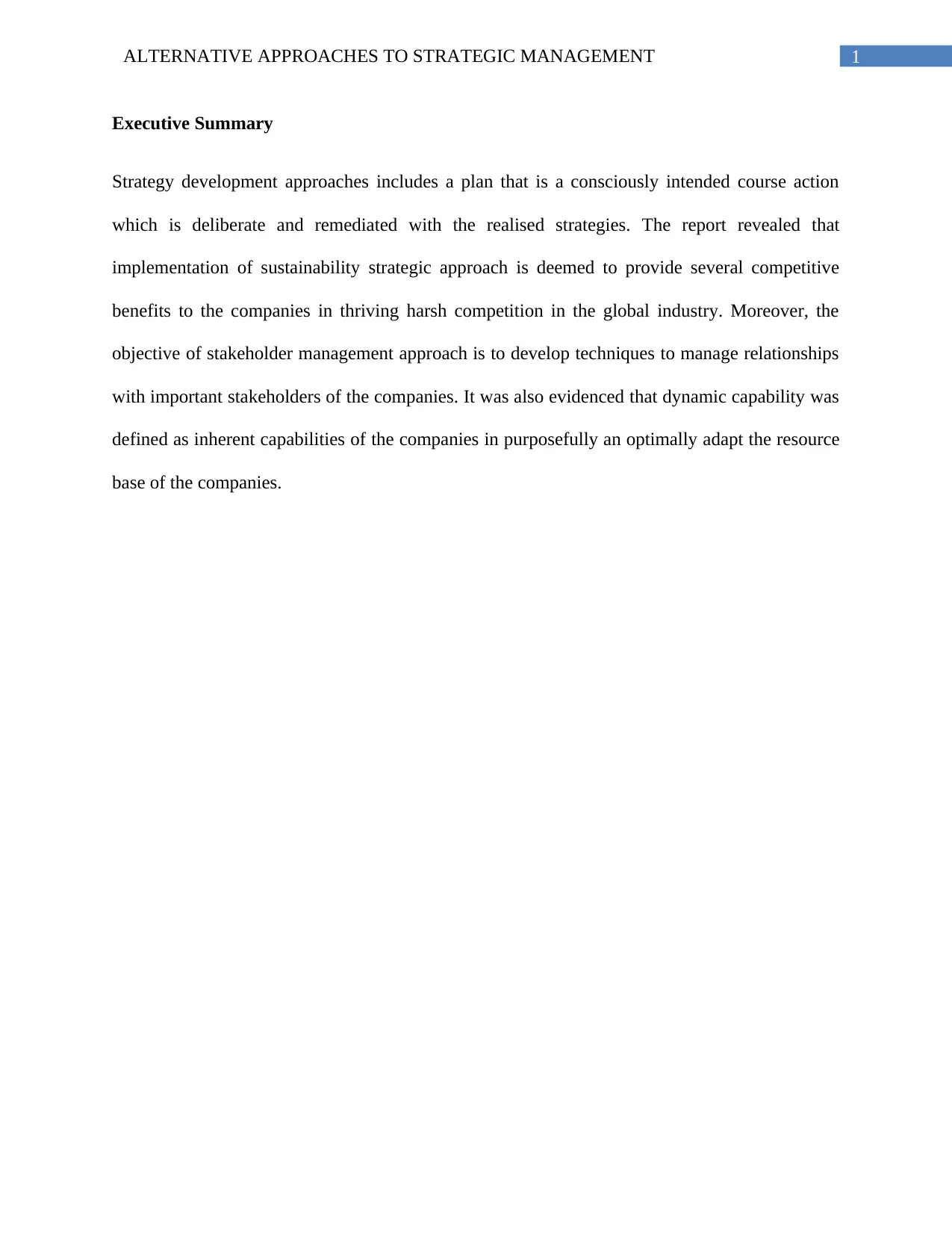
1ALTERNATIVE APPROACHES TO STRATEGIC MANAGEMENT
Executive Summary
Strategy development approaches includes a plan that is a consciously intended course action
which is deliberate and remediated with the realised strategies. The report revealed that
implementation of sustainability strategic approach is deemed to provide several competitive
benefits to the companies in thriving harsh competition in the global industry. Moreover, the
objective of stakeholder management approach is to develop techniques to manage relationships
with important stakeholders of the companies. It was also evidenced that dynamic capability was
defined as inherent capabilities of the companies in purposefully an optimally adapt the resource
base of the companies.
Executive Summary
Strategy development approaches includes a plan that is a consciously intended course action
which is deliberate and remediated with the realised strategies. The report revealed that
implementation of sustainability strategic approach is deemed to provide several competitive
benefits to the companies in thriving harsh competition in the global industry. Moreover, the
objective of stakeholder management approach is to develop techniques to manage relationships
with important stakeholders of the companies. It was also evidenced that dynamic capability was
defined as inherent capabilities of the companies in purposefully an optimally adapt the resource
base of the companies.
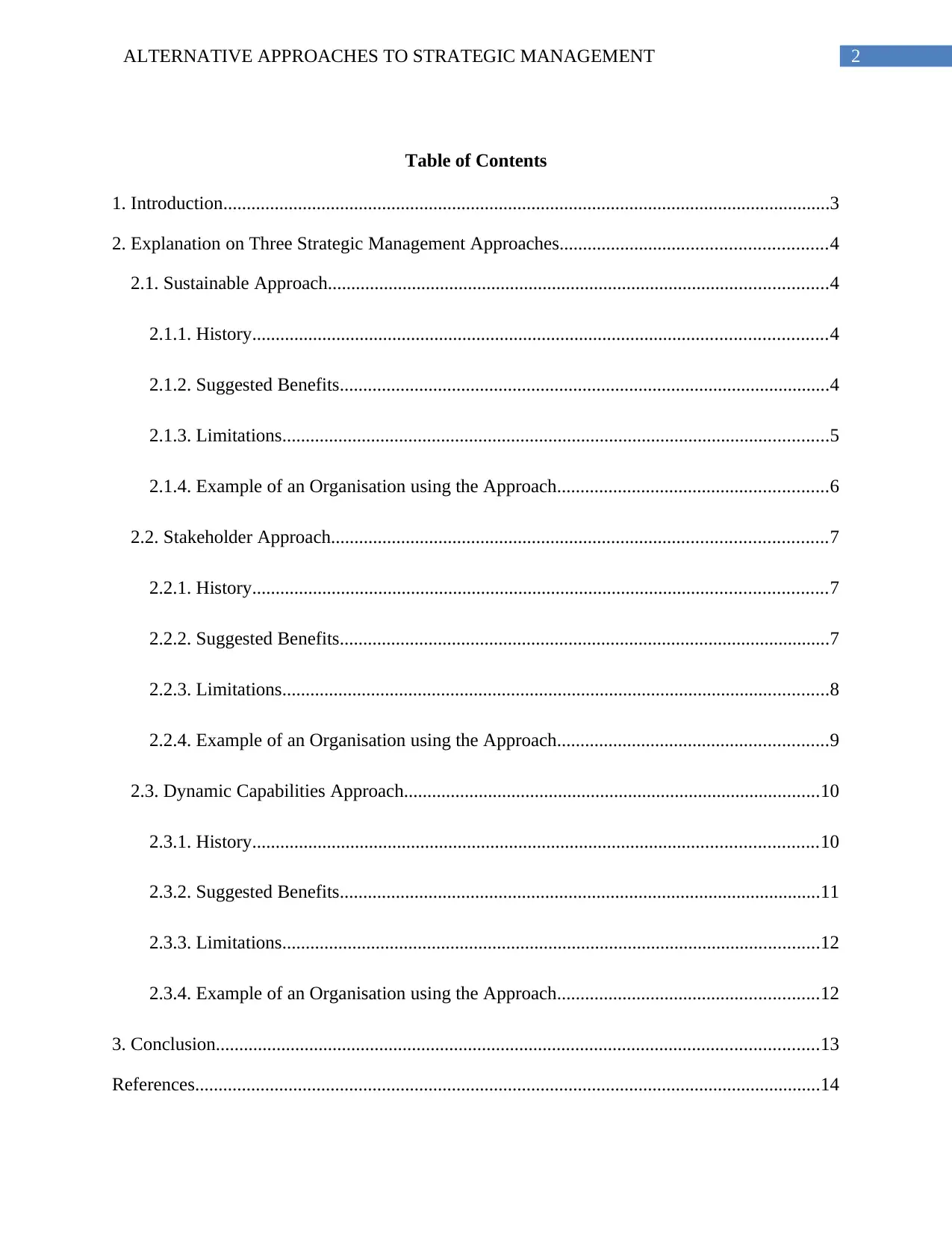
2ALTERNATIVE APPROACHES TO STRATEGIC MANAGEMENT
Table of Contents
1. Introduction..................................................................................................................................3
2. Explanation on Three Strategic Management Approaches.........................................................4
2.1. Sustainable Approach...........................................................................................................4
2.1.1. History...........................................................................................................................4
2.1.2. Suggested Benefits.........................................................................................................4
2.1.3. Limitations.....................................................................................................................5
2.1.4. Example of an Organisation using the Approach..........................................................6
2.2. Stakeholder Approach..........................................................................................................7
2.2.1. History...........................................................................................................................7
2.2.2. Suggested Benefits.........................................................................................................7
2.2.3. Limitations.....................................................................................................................8
2.2.4. Example of an Organisation using the Approach..........................................................9
2.3. Dynamic Capabilities Approach.........................................................................................10
2.3.1. History.........................................................................................................................10
2.3.2. Suggested Benefits.......................................................................................................11
2.3.3. Limitations...................................................................................................................12
2.3.4. Example of an Organisation using the Approach........................................................12
3. Conclusion.................................................................................................................................13
References......................................................................................................................................14
Table of Contents
1. Introduction..................................................................................................................................3
2. Explanation on Three Strategic Management Approaches.........................................................4
2.1. Sustainable Approach...........................................................................................................4
2.1.1. History...........................................................................................................................4
2.1.2. Suggested Benefits.........................................................................................................4
2.1.3. Limitations.....................................................................................................................5
2.1.4. Example of an Organisation using the Approach..........................................................6
2.2. Stakeholder Approach..........................................................................................................7
2.2.1. History...........................................................................................................................7
2.2.2. Suggested Benefits.........................................................................................................7
2.2.3. Limitations.....................................................................................................................8
2.2.4. Example of an Organisation using the Approach..........................................................9
2.3. Dynamic Capabilities Approach.........................................................................................10
2.3.1. History.........................................................................................................................10
2.3.2. Suggested Benefits.......................................................................................................11
2.3.3. Limitations...................................................................................................................12
2.3.4. Example of an Organisation using the Approach........................................................12
3. Conclusion.................................................................................................................................13
References......................................................................................................................................14
⊘ This is a preview!⊘
Do you want full access?
Subscribe today to unlock all pages.

Trusted by 1+ million students worldwide
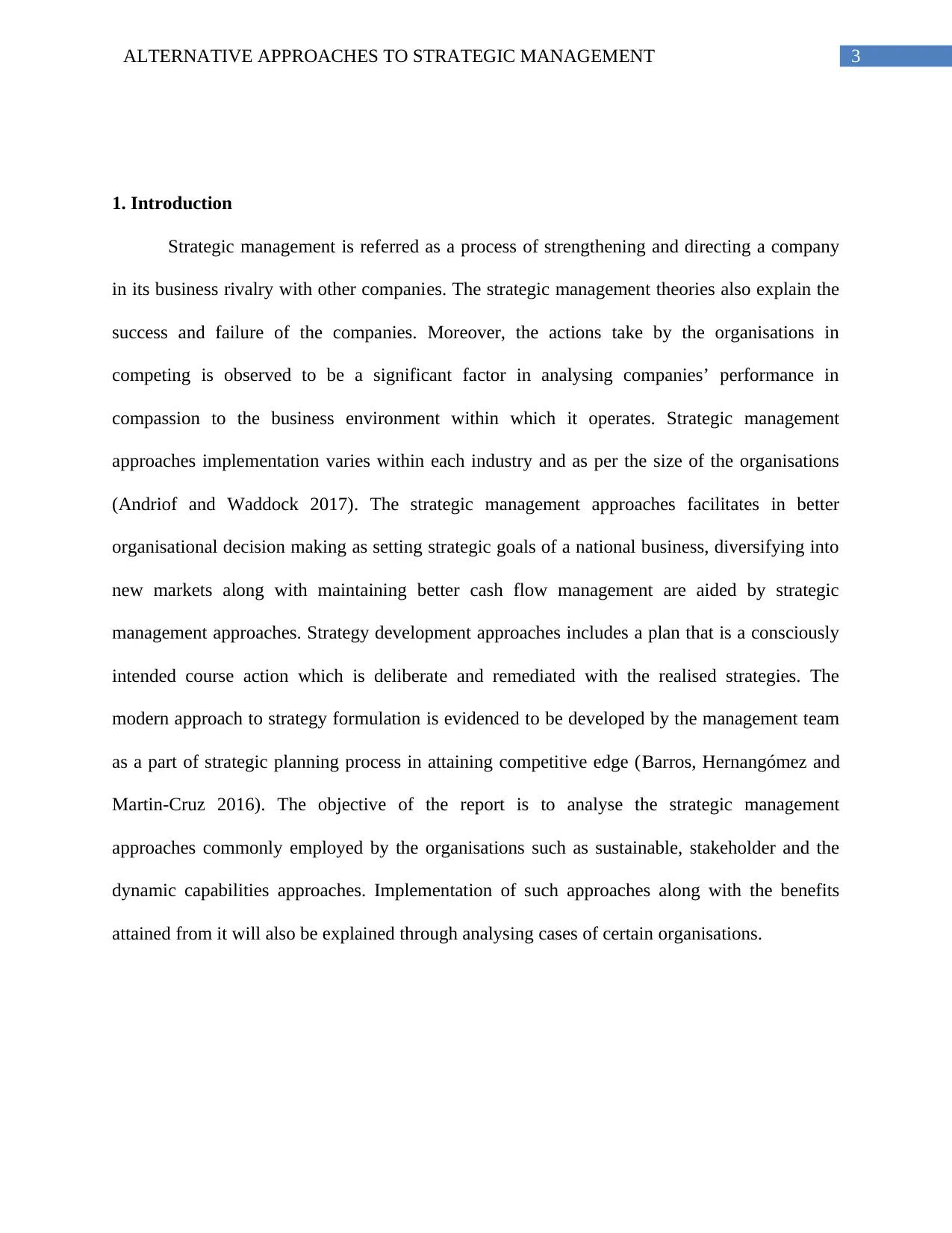
3ALTERNATIVE APPROACHES TO STRATEGIC MANAGEMENT
1. Introduction
Strategic management is referred as a process of strengthening and directing a company
in its business rivalry with other companies. The strategic management theories also explain the
success and failure of the companies. Moreover, the actions take by the organisations in
competing is observed to be a significant factor in analysing companies’ performance in
compassion to the business environment within which it operates. Strategic management
approaches implementation varies within each industry and as per the size of the organisations
(Andriof and Waddock 2017). The strategic management approaches facilitates in better
organisational decision making as setting strategic goals of a national business, diversifying into
new markets along with maintaining better cash flow management are aided by strategic
management approaches. Strategy development approaches includes a plan that is a consciously
intended course action which is deliberate and remediated with the realised strategies. The
modern approach to strategy formulation is evidenced to be developed by the management team
as a part of strategic planning process in attaining competitive edge (Barros, Hernangómez and
Martin-Cruz 2016). The objective of the report is to analyse the strategic management
approaches commonly employed by the organisations such as sustainable, stakeholder and the
dynamic capabilities approaches. Implementation of such approaches along with the benefits
attained from it will also be explained through analysing cases of certain organisations.
1. Introduction
Strategic management is referred as a process of strengthening and directing a company
in its business rivalry with other companies. The strategic management theories also explain the
success and failure of the companies. Moreover, the actions take by the organisations in
competing is observed to be a significant factor in analysing companies’ performance in
compassion to the business environment within which it operates. Strategic management
approaches implementation varies within each industry and as per the size of the organisations
(Andriof and Waddock 2017). The strategic management approaches facilitates in better
organisational decision making as setting strategic goals of a national business, diversifying into
new markets along with maintaining better cash flow management are aided by strategic
management approaches. Strategy development approaches includes a plan that is a consciously
intended course action which is deliberate and remediated with the realised strategies. The
modern approach to strategy formulation is evidenced to be developed by the management team
as a part of strategic planning process in attaining competitive edge (Barros, Hernangómez and
Martin-Cruz 2016). The objective of the report is to analyse the strategic management
approaches commonly employed by the organisations such as sustainable, stakeholder and the
dynamic capabilities approaches. Implementation of such approaches along with the benefits
attained from it will also be explained through analysing cases of certain organisations.
Paraphrase This Document
Need a fresh take? Get an instant paraphrase of this document with our AI Paraphraser
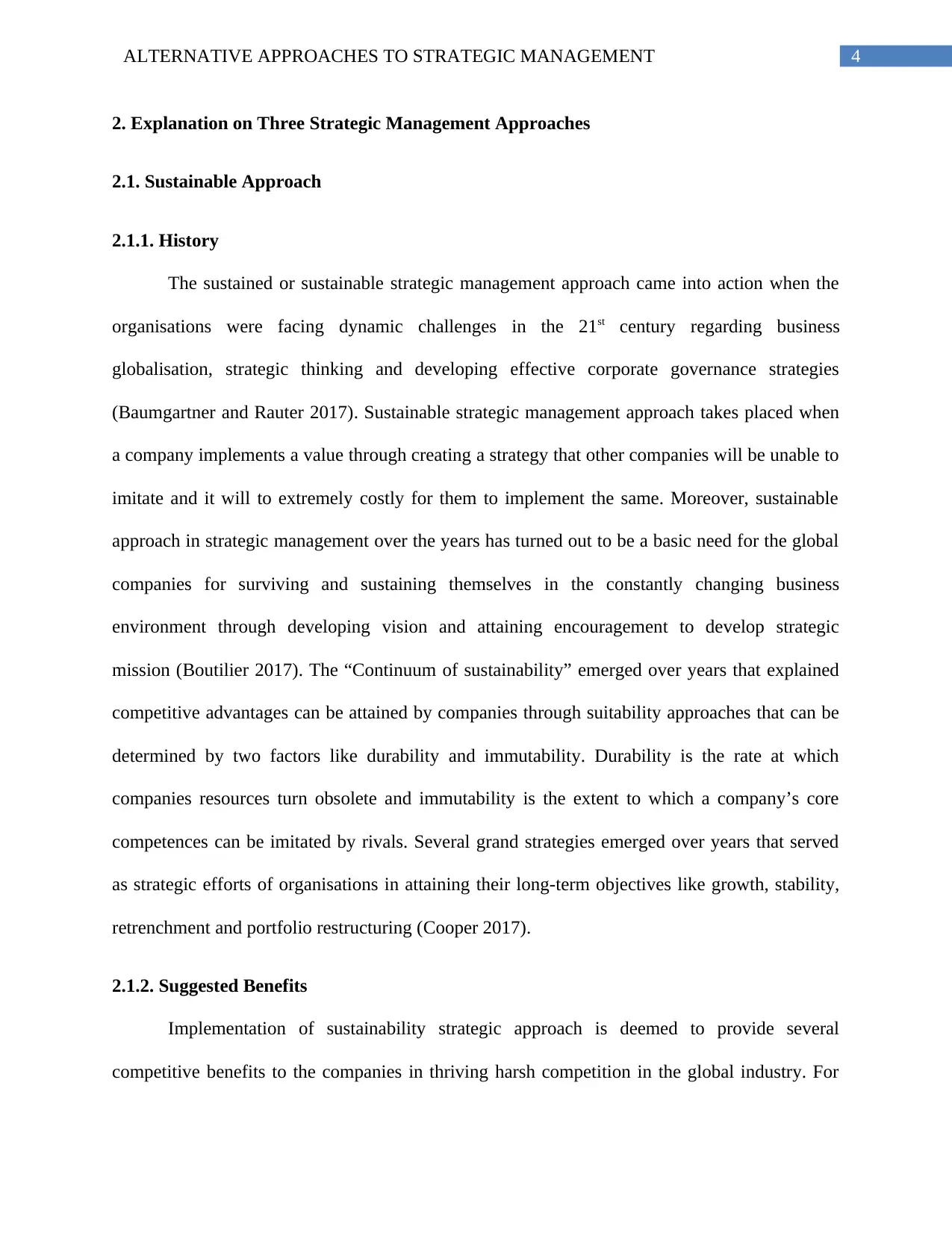
4ALTERNATIVE APPROACHES TO STRATEGIC MANAGEMENT
2. Explanation on Three Strategic Management Approaches
2.1. Sustainable Approach
2.1.1. History
The sustained or sustainable strategic management approach came into action when the
organisations were facing dynamic challenges in the 21st century regarding business
globalisation, strategic thinking and developing effective corporate governance strategies
(Baumgartner and Rauter 2017). Sustainable strategic management approach takes placed when
a company implements a value through creating a strategy that other companies will be unable to
imitate and it will to extremely costly for them to implement the same. Moreover, sustainable
approach in strategic management over the years has turned out to be a basic need for the global
companies for surviving and sustaining themselves in the constantly changing business
environment through developing vision and attaining encouragement to develop strategic
mission (Boutilier 2017). The “Continuum of sustainability” emerged over years that explained
competitive advantages can be attained by companies through suitability approaches that can be
determined by two factors like durability and immutability. Durability is the rate at which
companies resources turn obsolete and immutability is the extent to which a company’s core
competences can be imitated by rivals. Several grand strategies emerged over years that served
as strategic efforts of organisations in attaining their long-term objectives like growth, stability,
retrenchment and portfolio restructuring (Cooper 2017).
2.1.2. Suggested Benefits
Implementation of sustainability strategic approach is deemed to provide several
competitive benefits to the companies in thriving harsh competition in the global industry. For
2. Explanation on Three Strategic Management Approaches
2.1. Sustainable Approach
2.1.1. History
The sustained or sustainable strategic management approach came into action when the
organisations were facing dynamic challenges in the 21st century regarding business
globalisation, strategic thinking and developing effective corporate governance strategies
(Baumgartner and Rauter 2017). Sustainable strategic management approach takes placed when
a company implements a value through creating a strategy that other companies will be unable to
imitate and it will to extremely costly for them to implement the same. Moreover, sustainable
approach in strategic management over the years has turned out to be a basic need for the global
companies for surviving and sustaining themselves in the constantly changing business
environment through developing vision and attaining encouragement to develop strategic
mission (Boutilier 2017). The “Continuum of sustainability” emerged over years that explained
competitive advantages can be attained by companies through suitability approaches that can be
determined by two factors like durability and immutability. Durability is the rate at which
companies resources turn obsolete and immutability is the extent to which a company’s core
competences can be imitated by rivals. Several grand strategies emerged over years that served
as strategic efforts of organisations in attaining their long-term objectives like growth, stability,
retrenchment and portfolio restructuring (Cooper 2017).
2.1.2. Suggested Benefits
Implementation of sustainability strategic approach is deemed to provide several
competitive benefits to the companies in thriving harsh competition in the global industry. For

5ALTERNATIVE APPROACHES TO STRATEGIC MANAGEMENT
instance, it offers the benefits to the companies in reinforcing their business with more
competencies in conducting business activities in an innovative and better manner (Dentoni,
Bitzer and Pascucci 2016). Stability stratify under suitability approach facilitates the companies
in maintaining the status-quo to successfully continue their business activities in all their existing
global lie of businesses. Moreover, there are several other benefits of implementing sustainable
strategic management approach in the companies that are indicated below:
Enhanced brand image and competitive advantages: Brand image improves through
conducting “ethical business practices” ad through the public awareness advertisements.
Encouragement of resource conservation enhances brand awareness (Eaidgah et al.
2016).
Increases company ability to comply with regulations: With regard to the
environmental impact of businesses that government agencies have developed several
regulations and through nitrating sustainability approaches within businesses positions it
to address changing regulations in a timely manner.
Increase business productivity and decrease costs: Development of sustainable
strategic management approaches encourages efficient business operations that
streamline effort along with resource conservation that further improves employee
productivity and decreases costs (Garcia‐Castro and Aguilera 2015).
2.1.3. Limitations
Despite of having several benefits of implementing sustainability strategic management
approach within the business processes there are also certain limitations to its implementation
that are indicated under:
instance, it offers the benefits to the companies in reinforcing their business with more
competencies in conducting business activities in an innovative and better manner (Dentoni,
Bitzer and Pascucci 2016). Stability stratify under suitability approach facilitates the companies
in maintaining the status-quo to successfully continue their business activities in all their existing
global lie of businesses. Moreover, there are several other benefits of implementing sustainable
strategic management approach in the companies that are indicated below:
Enhanced brand image and competitive advantages: Brand image improves through
conducting “ethical business practices” ad through the public awareness advertisements.
Encouragement of resource conservation enhances brand awareness (Eaidgah et al.
2016).
Increases company ability to comply with regulations: With regard to the
environmental impact of businesses that government agencies have developed several
regulations and through nitrating sustainability approaches within businesses positions it
to address changing regulations in a timely manner.
Increase business productivity and decrease costs: Development of sustainable
strategic management approaches encourages efficient business operations that
streamline effort along with resource conservation that further improves employee
productivity and decreases costs (Garcia‐Castro and Aguilera 2015).
2.1.3. Limitations
Despite of having several benefits of implementing sustainability strategic management
approach within the business processes there are also certain limitations to its implementation
that are indicated under:
⊘ This is a preview!⊘
Do you want full access?
Subscribe today to unlock all pages.

Trusted by 1+ million students worldwide

6ALTERNATIVE APPROACHES TO STRATEGIC MANAGEMENT
The sustainability strategies has evidenced several instances of failure due to insufficient
funding and another limitation is an absence of a clearly documented and understood
association between the sustainability goals and the competitive strategies implemented
by the businesses (Harrison et al. 2019).
Integration of the sustainability commitments within the companies’ competitive strategy
plan is one of the major limitations of implementing sustainability approach along with
the issues faced by companies such as limited funding and senior executive support in the
path towards sustainability.
2.1.4. Example of an Organisation using the Approach
There are several instances of international companies that have attained success in
operating their business globally through maintaining competitive edge over their rivals through
effective implementation of sustainability strategic management approach. One such example of
a company is Starbucks in which the sustainability and competitive strategies are highly
integrated at a strategic planning level (Inigo, Albareda and Ritala 2017). The international
responsibility strategy is driven in the company’s strategic planning as well as annual operating
panning level. Starbucks successfully attains the benefits from sustainability approach through
attaining some management’s support for sustainability along with seeking natural ways to link
suitability with competitive approaches. This integration is maintained by Starbucks through
maintaining a wide amount of industry sustainability data, trends along with forecast with respect
to its efforts if strategic planning (Kim, Song and Triche 2015). The corporate strategic priorities
with a commitment to provide energy for a low carbon world has facilitated business operations
of Starbucks in integrating it with its sustainability strategies like high quality consumer services
and unmatched safety considerations of its consumers globally.
The sustainability strategies has evidenced several instances of failure due to insufficient
funding and another limitation is an absence of a clearly documented and understood
association between the sustainability goals and the competitive strategies implemented
by the businesses (Harrison et al. 2019).
Integration of the sustainability commitments within the companies’ competitive strategy
plan is one of the major limitations of implementing sustainability approach along with
the issues faced by companies such as limited funding and senior executive support in the
path towards sustainability.
2.1.4. Example of an Organisation using the Approach
There are several instances of international companies that have attained success in
operating their business globally through maintaining competitive edge over their rivals through
effective implementation of sustainability strategic management approach. One such example of
a company is Starbucks in which the sustainability and competitive strategies are highly
integrated at a strategic planning level (Inigo, Albareda and Ritala 2017). The international
responsibility strategy is driven in the company’s strategic planning as well as annual operating
panning level. Starbucks successfully attains the benefits from sustainability approach through
attaining some management’s support for sustainability along with seeking natural ways to link
suitability with competitive approaches. This integration is maintained by Starbucks through
maintaining a wide amount of industry sustainability data, trends along with forecast with respect
to its efforts if strategic planning (Kim, Song and Triche 2015). The corporate strategic priorities
with a commitment to provide energy for a low carbon world has facilitated business operations
of Starbucks in integrating it with its sustainability strategies like high quality consumer services
and unmatched safety considerations of its consumers globally.
Paraphrase This Document
Need a fresh take? Get an instant paraphrase of this document with our AI Paraphraser

7ALTERNATIVE APPROACHES TO STRATEGIC MANAGEMENT
2.2. Stakeholder Approach
2.2.1. History
The stakeholders approach to strategic management emerged in the year 1980s and the
reason behind implementation of such approach was to develop a strategic management
framework for organisations that is responsive to the concerns of the managers that were affected
by unprecedented levels of environmental change and turbulence (Kim, Song and Triche 2015).
Under this approach, competitive strategies are developed by the businesses by defining
stakeholders as by group or individual that is affect the attainment orb organisational objectives.
The objective of stakeholder management approach is to develop techniques to manage
relationships with important stakeholders of the companies including consumers, suppliers,
employees, investors and shareholders in attaining strategic competitive advantages. The major
issue during the 2000s has been whether the companies should run its operations for the benefit
of the shareholders or a broader group of stakeholders (Lai, Lin and Wang 2015). Considering
such issue several different approaches have been developed with high integration among
business operations and stakeholders. Considering same, stakeholder value turned out to be a
dominant theme within companies’ strategies over the past 25 years.
2.2.2. Suggested Benefits
There are several instances where the companies have attained advantages through
implementing stakeholder approach of strategic management within their business operations.
Certain important benefits that were identified related with stakeholder approach are indicated
below:
2.2. Stakeholder Approach
2.2.1. History
The stakeholders approach to strategic management emerged in the year 1980s and the
reason behind implementation of such approach was to develop a strategic management
framework for organisations that is responsive to the concerns of the managers that were affected
by unprecedented levels of environmental change and turbulence (Kim, Song and Triche 2015).
Under this approach, competitive strategies are developed by the businesses by defining
stakeholders as by group or individual that is affect the attainment orb organisational objectives.
The objective of stakeholder management approach is to develop techniques to manage
relationships with important stakeholders of the companies including consumers, suppliers,
employees, investors and shareholders in attaining strategic competitive advantages. The major
issue during the 2000s has been whether the companies should run its operations for the benefit
of the shareholders or a broader group of stakeholders (Lai, Lin and Wang 2015). Considering
such issue several different approaches have been developed with high integration among
business operations and stakeholders. Considering same, stakeholder value turned out to be a
dominant theme within companies’ strategies over the past 25 years.
2.2.2. Suggested Benefits
There are several instances where the companies have attained advantages through
implementing stakeholder approach of strategic management within their business operations.
Certain important benefits that were identified related with stakeholder approach are indicated
below:

8ALTERNATIVE APPROACHES TO STRATEGIC MANAGEMENT
It offers a single strategic framework that is highly flexible in dealing with numerous
business environment changes and without the implementation of new strategic plans by
the companies’ managers (Lloret 2016).
As the stakeholders have several benefits, implementation of stakeholder approach
facilitates the organisations in their effective decision making process. Moreover, this
approach of strategic management also facilitates in securing important resources that has
the capability in assisting decisions on important projects of business growth.
Stakeholder approach facilitates in building trust that further supports in better decision
making. Moreover, this strategic management approach emphasises active business
environment management, relationships along with promotions of shared interests
(Meixell and Luoma 2015). It also supports management in developing competitive
strategies through recognising and investing within all stakeholder relationships that can
ensure long-term success.
Understanding stakeholder relationships in a better manner can facilitate in successful
attainment of organisations growth objectives which in turn ensure survival of the
business.
2.2.3. Limitations
Despite having several useful implications and benefits of implementing stakeholder
approach of strategic management in the organisations there are certain imitations to this
approach that needs careful consideration from the companies. Few of such major limitations of
this approach are indicated below:
At times the stakeholders of the organisations are centred on attaining their own interests
that is deemed to be a very common issue with specifically the external stakeholders. The
It offers a single strategic framework that is highly flexible in dealing with numerous
business environment changes and without the implementation of new strategic plans by
the companies’ managers (Lloret 2016).
As the stakeholders have several benefits, implementation of stakeholder approach
facilitates the organisations in their effective decision making process. Moreover, this
approach of strategic management also facilitates in securing important resources that has
the capability in assisting decisions on important projects of business growth.
Stakeholder approach facilitates in building trust that further supports in better decision
making. Moreover, this strategic management approach emphasises active business
environment management, relationships along with promotions of shared interests
(Meixell and Luoma 2015). It also supports management in developing competitive
strategies through recognising and investing within all stakeholder relationships that can
ensure long-term success.
Understanding stakeholder relationships in a better manner can facilitate in successful
attainment of organisations growth objectives which in turn ensure survival of the
business.
2.2.3. Limitations
Despite having several useful implications and benefits of implementing stakeholder
approach of strategic management in the organisations there are certain imitations to this
approach that needs careful consideration from the companies. Few of such major limitations of
this approach are indicated below:
At times the stakeholders of the organisations are centred on attaining their own interests
that is deemed to be a very common issue with specifically the external stakeholders. The
⊘ This is a preview!⊘
Do you want full access?
Subscribe today to unlock all pages.

Trusted by 1+ million students worldwide

9ALTERNATIVE APPROACHES TO STRATEGIC MANAGEMENT
stakeholder group might be political appointees or community groups that might not act
in the best interests of the organisations in case the business is not offering aspects that
provide benefits to the stakeholders with their constituents (Sala, Ciuffo and Nijkamp
2015).
Moreover in following the stakeholder approach of maintaining better relationships with
them, the internal stakeholders like the inexperienced investors might vote against the
growth proposal of the companies in case they fee there is an uncertainty that thy might
lose their money. They can be focused on attaining their own financial needs rather than
supporting companies’ sustainability needs.
2.2.4. Example of an Organisation using the Approach
On of leading retail chains such as Tesco have implemented stakeholder approach of
strategic management in attaining international business growth and success. Implementing this
strategic management approach the company has implemented innovative changes in business
for attaining competitive advantages (Schaltegger, Hansen and Lüdeke-Freund 2016). Change
management strategies of Tesco are aligned with its effective stakeholder management initiatives
where they actively identify the major stakeholders that can support the company’s strategic
change process. In this approach the retail company also considers prioterisng their stakeholders
through classifying then by their power over work and by their trust within the work. Tesco
keeps its vital stakeholders informed and makes them a part of the business growth decision
making process through effective stakeholder communication strategy so that they perceive
themselves as an important art in attaining company’s strategic objectives (Tantalo and Priem
2016). Developing good relationship ith its stakeholders facilitates Tesco in implementing
change fur its business growth successfully. In implementing stakeholders’ approach of strategic
stakeholder group might be political appointees or community groups that might not act
in the best interests of the organisations in case the business is not offering aspects that
provide benefits to the stakeholders with their constituents (Sala, Ciuffo and Nijkamp
2015).
Moreover in following the stakeholder approach of maintaining better relationships with
them, the internal stakeholders like the inexperienced investors might vote against the
growth proposal of the companies in case they fee there is an uncertainty that thy might
lose their money. They can be focused on attaining their own financial needs rather than
supporting companies’ sustainability needs.
2.2.4. Example of an Organisation using the Approach
On of leading retail chains such as Tesco have implemented stakeholder approach of
strategic management in attaining international business growth and success. Implementing this
strategic management approach the company has implemented innovative changes in business
for attaining competitive advantages (Schaltegger, Hansen and Lüdeke-Freund 2016). Change
management strategies of Tesco are aligned with its effective stakeholder management initiatives
where they actively identify the major stakeholders that can support the company’s strategic
change process. In this approach the retail company also considers prioterisng their stakeholders
through classifying then by their power over work and by their trust within the work. Tesco
keeps its vital stakeholders informed and makes them a part of the business growth decision
making process through effective stakeholder communication strategy so that they perceive
themselves as an important art in attaining company’s strategic objectives (Tantalo and Priem
2016). Developing good relationship ith its stakeholders facilitates Tesco in implementing
change fur its business growth successfully. In implementing stakeholders’ approach of strategic
Paraphrase This Document
Need a fresh take? Get an instant paraphrase of this document with our AI Paraphraser
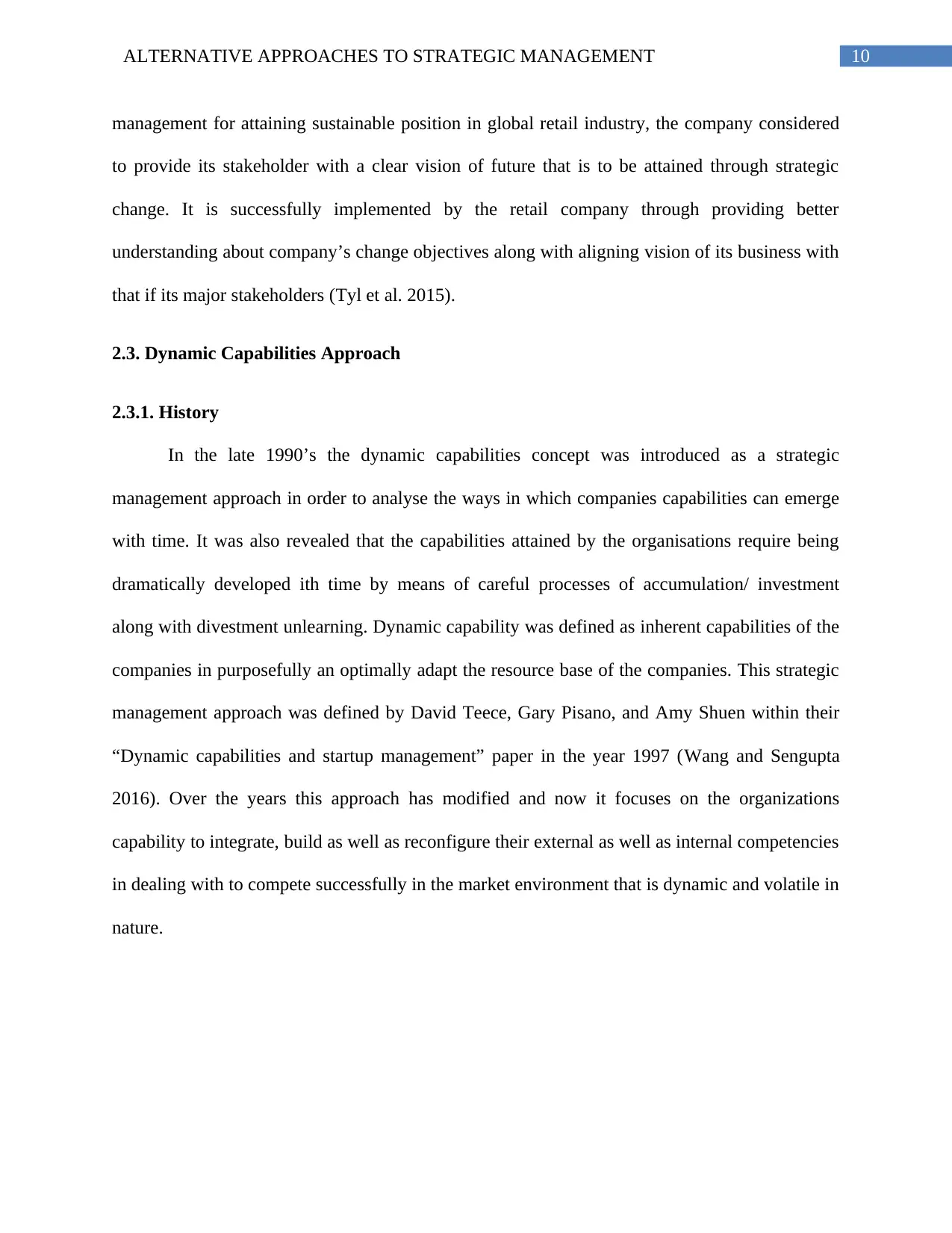
10ALTERNATIVE APPROACHES TO STRATEGIC MANAGEMENT
management for attaining sustainable position in global retail industry, the company considered
to provide its stakeholder with a clear vision of future that is to be attained through strategic
change. It is successfully implemented by the retail company through providing better
understanding about company’s change objectives along with aligning vision of its business with
that if its major stakeholders (Tyl et al. 2015).
2.3. Dynamic Capabilities Approach
2.3.1. History
In the late 1990’s the dynamic capabilities concept was introduced as a strategic
management approach in order to analyse the ways in which companies capabilities can emerge
with time. It was also revealed that the capabilities attained by the organisations require being
dramatically developed ith time by means of careful processes of accumulation/ investment
along with divestment unlearning. Dynamic capability was defined as inherent capabilities of the
companies in purposefully an optimally adapt the resource base of the companies. This strategic
management approach was defined by David Teece, Gary Pisano, and Amy Shuen within their
“Dynamic capabilities and startup management” paper in the year 1997 (Wang and Sengupta
2016). Over the years this approach has modified and now it focuses on the organizations
capability to integrate, build as well as reconfigure their external as well as internal competencies
in dealing with to compete successfully in the market environment that is dynamic and volatile in
nature.
management for attaining sustainable position in global retail industry, the company considered
to provide its stakeholder with a clear vision of future that is to be attained through strategic
change. It is successfully implemented by the retail company through providing better
understanding about company’s change objectives along with aligning vision of its business with
that if its major stakeholders (Tyl et al. 2015).
2.3. Dynamic Capabilities Approach
2.3.1. History
In the late 1990’s the dynamic capabilities concept was introduced as a strategic
management approach in order to analyse the ways in which companies capabilities can emerge
with time. It was also revealed that the capabilities attained by the organisations require being
dramatically developed ith time by means of careful processes of accumulation/ investment
along with divestment unlearning. Dynamic capability was defined as inherent capabilities of the
companies in purposefully an optimally adapt the resource base of the companies. This strategic
management approach was defined by David Teece, Gary Pisano, and Amy Shuen within their
“Dynamic capabilities and startup management” paper in the year 1997 (Wang and Sengupta
2016). Over the years this approach has modified and now it focuses on the organizations
capability to integrate, build as well as reconfigure their external as well as internal competencies
in dealing with to compete successfully in the market environment that is dynamic and volatile in
nature.
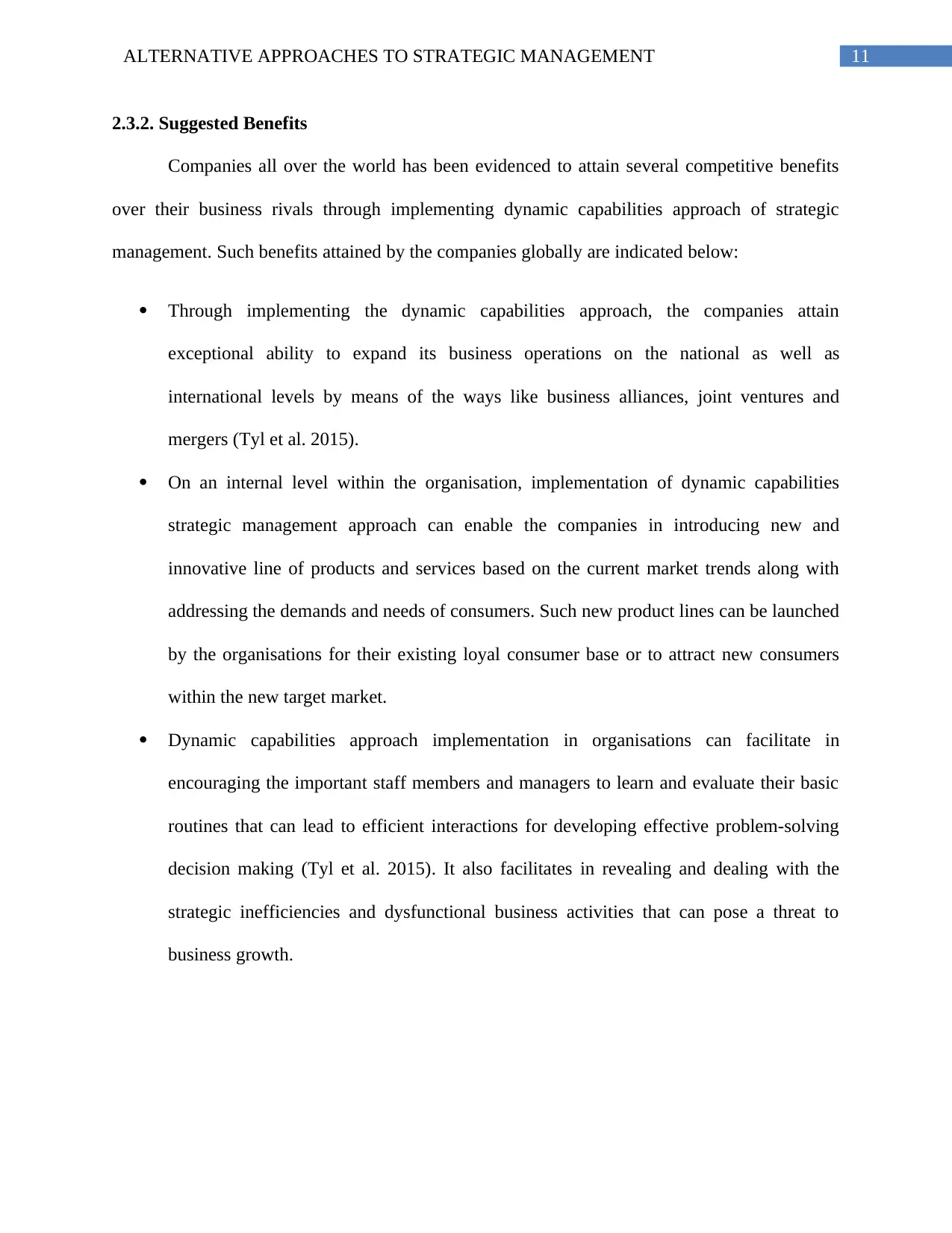
11ALTERNATIVE APPROACHES TO STRATEGIC MANAGEMENT
2.3.2. Suggested Benefits
Companies all over the world has been evidenced to attain several competitive benefits
over their business rivals through implementing dynamic capabilities approach of strategic
management. Such benefits attained by the companies globally are indicated below:
Through implementing the dynamic capabilities approach, the companies attain
exceptional ability to expand its business operations on the national as well as
international levels by means of the ways like business alliances, joint ventures and
mergers (Tyl et al. 2015).
On an internal level within the organisation, implementation of dynamic capabilities
strategic management approach can enable the companies in introducing new and
innovative line of products and services based on the current market trends along with
addressing the demands and needs of consumers. Such new product lines can be launched
by the organisations for their existing loyal consumer base or to attract new consumers
within the new target market.
Dynamic capabilities approach implementation in organisations can facilitate in
encouraging the important staff members and managers to learn and evaluate their basic
routines that can lead to efficient interactions for developing effective problem-solving
decision making (Tyl et al. 2015). It also facilitates in revealing and dealing with the
strategic inefficiencies and dysfunctional business activities that can pose a threat to
business growth.
2.3.2. Suggested Benefits
Companies all over the world has been evidenced to attain several competitive benefits
over their business rivals through implementing dynamic capabilities approach of strategic
management. Such benefits attained by the companies globally are indicated below:
Through implementing the dynamic capabilities approach, the companies attain
exceptional ability to expand its business operations on the national as well as
international levels by means of the ways like business alliances, joint ventures and
mergers (Tyl et al. 2015).
On an internal level within the organisation, implementation of dynamic capabilities
strategic management approach can enable the companies in introducing new and
innovative line of products and services based on the current market trends along with
addressing the demands and needs of consumers. Such new product lines can be launched
by the organisations for their existing loyal consumer base or to attract new consumers
within the new target market.
Dynamic capabilities approach implementation in organisations can facilitate in
encouraging the important staff members and managers to learn and evaluate their basic
routines that can lead to efficient interactions for developing effective problem-solving
decision making (Tyl et al. 2015). It also facilitates in revealing and dealing with the
strategic inefficiencies and dysfunctional business activities that can pose a threat to
business growth.
⊘ This is a preview!⊘
Do you want full access?
Subscribe today to unlock all pages.

Trusted by 1+ million students worldwide
1 out of 17
Related Documents
Your All-in-One AI-Powered Toolkit for Academic Success.
+13062052269
info@desklib.com
Available 24*7 on WhatsApp / Email
![[object Object]](/_next/static/media/star-bottom.7253800d.svg)
Unlock your academic potential
Copyright © 2020–2025 A2Z Services. All Rights Reserved. Developed and managed by ZUCOL.




